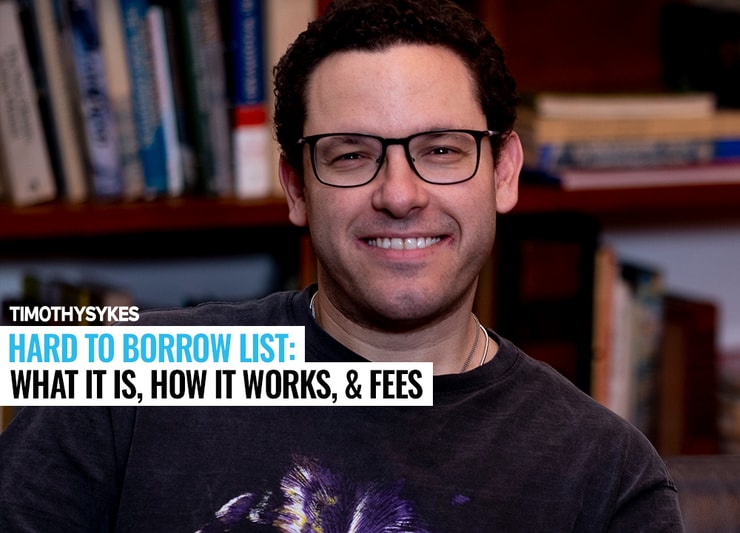Some of the stocks I trade are hard to borrow. No, I don’t short much these days, but I still understand how different traders approach the market.
Shorting penny stocks is risky. It’s not something I teach newbies in my Trading Challenge. For one, there’s limited potential gain from a short position. Stocks can only drop to zero.
The flip side is that some stocks can climb indefinitely. Remember the billionaire hedge funds that got squeezed on GameStop (NYSE: GME)?
If you short, you could potentially lose exponentially more than you put in. And if billionaire hedge funds can go bust, SO CAN YOU.
That’s why my #1 rule is to always cut losses quickly. Holding and hoping is for suckers. If a stock doesn’t follow my pattern, I get out.
That rule is especially important for a short seller like David. He reached $100,000 in trading profits after countless hours of dedicated studying.*
David is not a normal trader. He approached short selling with an athlete mindset and is now seeing his hard work pay off. And guess what? He’s still working hard. That’s what it takes.
Shorting is more complicated than long positions. That’s another reason I don’t teach it to newbies.
The hard-to-borrow list is a perfect example of that complexity…
To short a stock, traders must borrow shares from their broker. Then they sell the shares and buy them back to close the position … hopefully at a lower price.
And some stocks aren’t easy to borrow. Let’s review the reasons why and what you should know before trading them.
Table of Contents
- 1 What Does It Mean if a Stock Is Hard to Borrow?
- 2 What Is the Hard-to-Borrow List?
- 3 How Does the List Work?
- 4 What About Easy to Borrow?
- 5 Regulations
- 6 How Are Hard-to-Borrow Fees Calculated?
- 7 How Do You Know if There Are Shares Available to Borrow?
- 8 Are Options Affected?
- 9 Frequently Asked Questions About Hard-to-Borrow Stocks
- 10 The Bottom Line on Hard-to-Borrow Stocks
What Does It Mean if a Stock Is Hard to Borrow?

2025 Millionaire Media, LLCAgain, when you short a stock, you’re borrowing shares.
Your broker can borrow shares for you from another account or another brokerage firm.
The total number of shortable shares is equal to the company’s float. Technically, you can short more, but that gets complicated.
If there are too many shares of a stock held short, brokers can put the stock on a hard-to-borrow list. Usually, that’s when there’s a dwindling number of shortable shares in the market. Volatile stocks can also end up on the list.
Remember, short positions can lose an unlimited amount of money. Brokers know this better than anyone.
So if some newbie loses more than they can pay, the broker loses too. Stocks that have big price swings can be hard to borrow — that’s to help protect brokers and traders.
It’s more difficult to find shares of these stocks but not impossible…
Traders can request a short locate. Your broker will go on the hunt for any available shortable shares.
But don’t be too eager about what they come back with and brace yourself for higher fees. It can be expensive to short stocks.
Some traders profit from this strategy but a trading plan is essential. Sometimes, even if the trade goes well, you can still lose money through fees.
What Is the Hard-to-Borrow List?
This list is a confidential — for brokers’ eyes only — catalog of restricted stocks.
There’s a new list every day. It all depends on which stocks are most volatile and how much of the float traders can short.
How Does the List Work?
Say a broker adds a stock to the hard-to-borrow list. Now what?
If a trader tries to short the stock, their broker won’t fill the order without a short locate.
Again, these stocks may be restricted to protect traders. That’s due to the risky nature of shorting. Stocks with a lot of short interest are more susceptible to short squeezes.
A short squeeze happens when a heavily shorted stock starts to uptrend. If the shorts want to exit, they have to buy back their shares. Now long positions are buying into an uptrending stock and short positions are buying to get out.
All that buying can make a stock spike.
I mentioned the GameStop short squeeze earlier. It’s a perfect example of a heavily shorted stock that spiked big.
GME ran from the teens to $400 in January.

My condolences to any shorts who got caught. Losing in the stock market is never fun. I don’t wish it on anyone. But studying and experience can help keep traders safe.
If you got stuck in a short squeeze it’s probably because you didn’t study enough. Maybe you didn’t have enough experience in a volatile market. Or maybe you gave in to greed. It happens. But I wouldn’t let it happen again…
Check out my four-hour no-cost “Volatility Survival Guide” to learn how to safely trade volatile stocks.
What About Easy to Borrow?

2025 Millionaire Media, LLCYou might be thinking, “Tim, which stocks can I borrow?”
Excellent question. There’s also an easy-to-borrow list.
Unlike the hard-to-borrow list, brokers share easy-to-borrow stocks on their websites. Brokers update it daily, and it contains all the stocks with easy-to-short shares.
It is important to keep an eye on this list. It fluctuates with market changes and news catalysts. If you’re learning with stocks that are easy to borrow, following this list is a great place to start.
Watching how a stock moves before making a trade can help you make a more informed trading plan.
All my top students spent hours, weeks, months, and years watching the market move. They know how critical it is to understand certain indicators and how stocks have moved in the past.
You have to learn to react to the action.
Tim Lento is one of my early Challenge students who now helps teach newbies and moderate chat. He mainly shorts. Tim knows how important it is to watch and react to what the stock does.
Trading hard-to-borrow stocks requires a high level of discipline and quick reaction. The regulations make it even tougher. Let’s take a look…
Regulations
Once flagged as hard to borrow, shares become notoriously hard to find. As I noted, traders can ask brokers to locate shares. They don’t usually come cheap.
Borrowed shares come with interest and fees. Hard-to-borrow stocks are some of the most expensive to short. Again, that’s due to limited availability and higher perceived risk to brokers and traders.
And the longer you hold a short position, as in multiple days, the more it will cost. Opening and closing a short position within a trading day may exempt you from hard-to-borrow fees.
Also, the longer you hold a short position, the higher the chance your broker will force you to buy to cover.
Say the lender decides to sell their position. The broker has no other choice than to close short positions to create available shares.
Brokers can also cover shorts if the volatility is causing too great of a loss for the position.
Have I mentioned shorting is dangerous? Let’s take a closer look at the fees…
How Are Hard-to-Borrow Fees Calculated?
Brokers calculate fees using the value of the short position and the hard-to-borrow rate for that stock.
Remember, the hard-to-borrow list changes daily, which means the rate changes too. Also, the value of the position will change as the price changes.
The result is a constantly fluctuating cost. The daily fee of holding the stock short won’t always be the same.
The rate fluctuates based on available shares and volatility. For some stocks, the rate is such a high percentage that it can dent potential profits.
It’s important to keep an eye on the fees while in a short position, especially since the cost can change so quickly.
Hard-to-borrow stocks can be a pain for short sellers.
Brokers mark the stock on their website so that traders know there are limited shares. If you’re unsure, contact your broker for more information.
To be certain that the stock you’re watching has enough shares to short, pick from the easy-to-borrow list. Brokers include stocks that have a low short interest to let traders know there are shares available to borrow.
But just because you short an easy-to-borrow stock doesn’t guarantee safety from forced covering. If you’re losing big in a short position on a volatile stock, your broker can force you out.
Are Options Affected?
I don’t trade options. But some top Trading Challenge traders do, like mentor Mark Croock. He applies the strategies he learned in penny stocks to options. It can potentially be another great way to grow a small account — with enough time and dedication.
The hard-to-borrow list doesn’t affect options trading the same way it does OTC without any problems. They’re pretty good about borrowing shares for short selling. The mechanics of the two trading styles are different.
It’s not likely that stocks on the list are optionable. Options depend on higher volume, a minimum share price, and high outstanding shares. Most hard-to-borrow stocks are penny stocks that don’t usually fit the criteria for options.
Traders may owe fees on options positions if they exercise a contract resulting in a short sale of the stock.
Frequently Asked Questions About Hard-to-Borrow Stocks
Short sellers don’t own borrowed shares. The original lender may still sell to exit the position. If that happens, the broker will contact the short seller to liquidate their position. Filling the lender’s order is the priority since they’re the rightful owner of the shares.
What Is a Hard-to-Borrow Rate?
Some stocks come with higher fees to short. Borrow fees vary depending on availability of shares and volatility. Brokers calculate the hard-to-borrow rate for each stock individually, which influences fees. The rate can change daily, so stay up to date when holding short positions overnight.
More Breaking News
- Albion Resources Shares Surge as Drilling Commences in Yandal West
- Builders FirstSource: Stock Soaring Feat or Fleeting Fame?
- Stock Surge Inquiry: CNR’s Steep Upward Trajectory
Borrow fees are usually a fraction of the price. But they change daily for every stock. For hard-to-borrow stocks, fees are much higher. Short selling is risky enough without all the additional fees. Always make sure you know how much you’re risking and contact your broker if you have questions.
Short sellers don’t own the shares they’re trading. If companies pay dividends on borrowed shares, the broker will contact the short seller to pay the dividend amount to the lender. There’s a lot to keep track of when you’re short selling. Clear up any questions and concerns you have with your broker before making a trade.
The Bottom Line on Hard-to-Borrow Stocks

2025 Millionaire Media, LLCI don’t suggest shorting stocks. It’s too dangerous for newbies. Even professional short sellers can lose too much.
Hard-to-borrow stocks are some of the most dangerous.
The fees are expensive and usually, crazy volatility is right around the corner. Yes, I love volatility. It can be great for long positions if you’re experienced and patient…
It’s a different game with shorting. So to me, the cons outweigh any pros for watchlist in kind. FOR EXAMPLE, a period of deflation might bring more opportunities for short selling. But it’s important to understand it even if it’s not your strategy.
I’ve been trading for over two decades. Sometimes I trade heavily shorted stocks, but only if they fit my patterns.
The more you know about the stock market, the better prepared you’ll be. Make sure to study as much as you can and learn from everything.
Ready to start learning the right way? Apply to join my Trading Challenge. Once accepted, you’ll have access to a huge library of video lessons, live trade webinars, and the Challenge chat room.
Just getting started? Check out the 30-Day Bootcamp. It’s a great way to build your trading foundation.
What do you think about the hard-to-borrow list? Have you ever watched one of these stocks turn into a short squeeze? Comment below, I love to hear from my readers!












Leave a reply